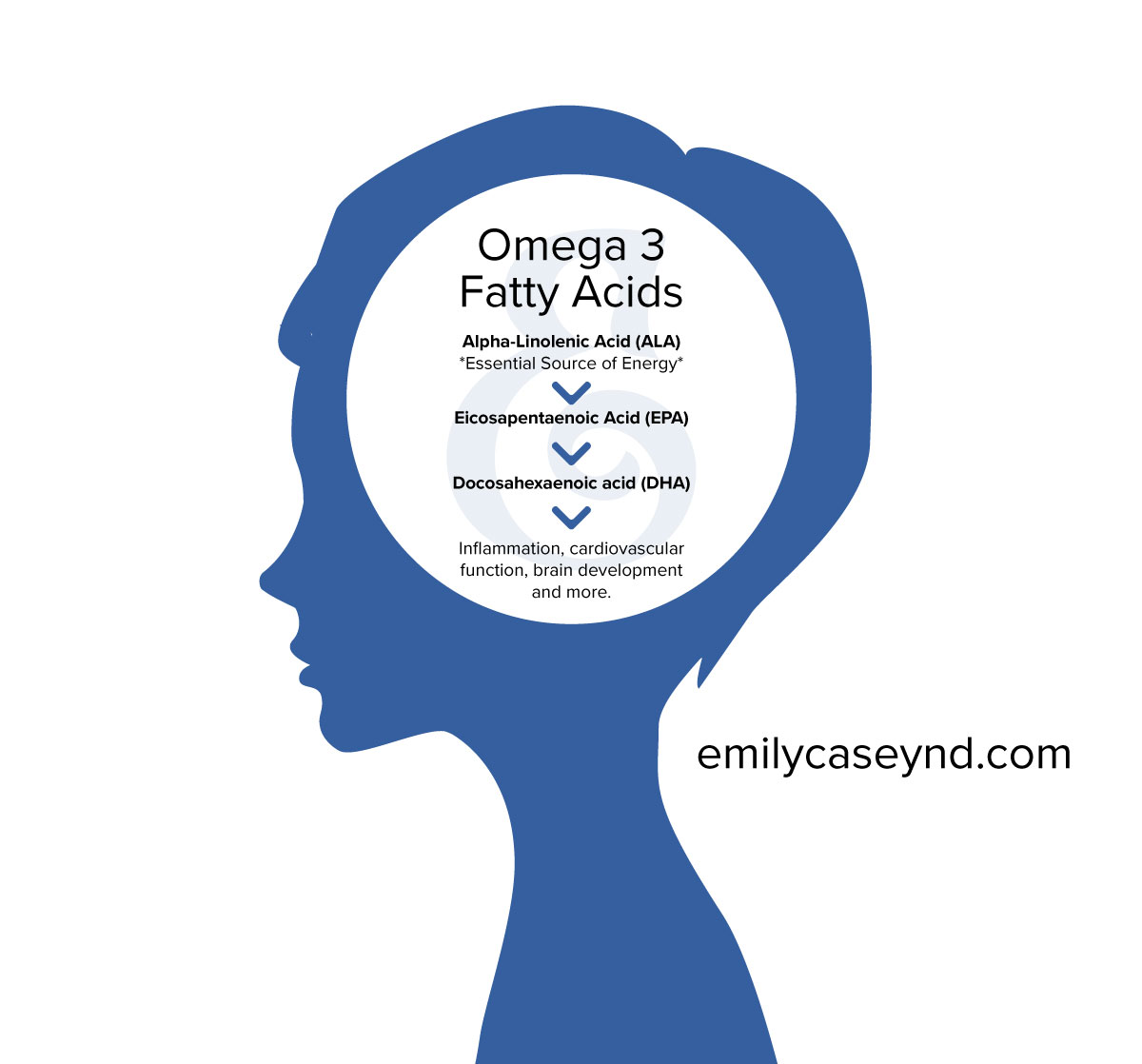01 Oct October Omegas
What do you know about omega-3 fatty acids? I’m guessing that the majority of you have heard the hype about their importance but do you really understand why you should be eating them and which sources are optimal? And have you heard about omega-6 and omega-9? Those are some of the questions I will answer for you in this month’s blog post! Read on to learn more about who can benefit from eating omega-3 fatty acids (hint: everybody!) and which health conditions can specifically benefit from additional omega-3 supplementation (hint: inflammatory conditions!)

Essential Fatty Acids
The essential fatty acids, meaning they cannot be synthesized in our body and must be ingested in our food, are linoleic acid (omega-6 fatty acid) and alpha-linolenic acid (omega-3 fatty acid). These fatty acids are required for numerous functions in our body, including energy production, cell membrane structure, and brain health and development. They are also mediators for inflammation, vasoconstriction, and platelet aggregation.
The fatty acids that are related to omega-3 fatty acids are called eicosapentaenoic acid (EPA) and docosahexaenoic acid (DHA). These are not technically essential because they can be converted from alpha-linolenic acid (omega-3 fatty acid). However, this conversion is limited and many of the health benefits associated with omega-3 fatty acids actually come from the EPA and DHA. This is why it is important to not only focus on getting omega-3 sources in your diet, but also consume EPA and DHA sources (or supplement your diet with them).
Omega-9 is related to omega-3 and omega-6 but it is non-essential. Omega-9 is synthesized by the body from other fatty acids and it is also readily available in a variety of animal and vegetable oils. Getting adequate amounts of omega-9 is not a common concern.
Omega-3:Omega-6 Ratio
Why do you hear so much about the importance of eating omega-3 but very little about needing more omega-6? Although both are essential fatty acids, a severe deficiency of omega-3 or omega-6 is very uncommon in the developed world. However, the more common issue is an imbalance in the ratio of omega-3 to omega-6 consumption. They compete for the same pathway in the body, which means that an excess intake of one can lead to decreased tissue levels and metabolism of the other. The omega-6 pathway leads to production of more pro-inflammatory prostaglandins, while the omega-3 pathways leads to the production of anti-inflammatory prostaglandins.
Ideally, omega-3 and omega-6 should be eaten in a 1:1 ratio. However, the Standard North American Diet (high in sugar, saturated fats, and processed foods) commonly includes 10-20 times more omega-6 compared to omega-3. This makes it very hard for our body to convert the omega-3 fatty acids into the EPA and DHA molecules that are essential for modulating inflammation in the body. It is this imbalance that explains why healthcare professionals are recommending increasing omega-3 dietary sources, while actually limiting omega-6 sources.
An interesting question is whether this change in the omega-3 to omega-6 ratio in the current North American diet is a contributing factor to a variety of chronic diseases. Could the health benefits of omega-3 supplementation be related to the optimization of this ratio? We don’t have these answers yet but it’s definitely a significant question to consider.
Omega-3 and Omega-6 Food Sources
Alpha Linolenic Acid (Omega-3): flax seeds, chia seeds, hemp seeds, walnuts, canola, and soybean oil.
EPA and DHA: Fish and seafood, such as cod, haddock, herring, mackerel, sardines, salmon, trout, tuna, halibut, sole, grouper, snapper, etc. The levels are especially high in cold-water fish, including salmon, sardines, herring, mackerel.
Linoleic Acid (Omega-6): safflower, sunflower, corn, sesame, soybean, and canola oils. These are the oils commonly used in processed foods.

To improve your omega-3 to omega-6 ratio, aim to consume fewer processed foods to decrease your omega-6 intake. To increase your omega-3 intake, focus on healthy fats, including flax seeds, chia seeds, hemp seeds, pumpkin seeds, walnuts, and, most importantly, lots of fish! Aim for at least 2-3 servings of fish per week. Check out EWG’s Consumer Guide to Seafood to better understand the omega-3 and mercury levels of a variety of fish.
Understanding EPA and DHA
To optimize the uses and positive effects listed below, it is beneficial to focus on increasing dietary sources and/or supplementation of EPA and DHA (fish and fish oil), not omega-3 alone. EPA is specifically known for being anti-inflammatory, hypolipidemic (reducing blood levels of triglycerides), and antithrombotic (blood thinning). DHA is specifically known for being anti-inflammatory and it is essential for the development and functioning of the brain and central nervous system.
Uses of Omega-3, EPA, and DHA
Depression and other mood disorders: As we begin to understand more about the underlying causes of depression and other mood disorders, it appears that they can commonly be related to increased inflammation in the body. Fish oil can be used to decrease inflammation and improve overall mood. A fish oil supplement with a 3:1 ratio of EPA:DHA is commonly used in this scenario.
Asthma, eczema, rheumatoid arthritis, and other inflammatory disorders: EPA and DHA are precursors to prostaglandins and other molecules in the body that decrease systemic inflammation. Increasing EPA and DHA through food sources or supplementation can lead to decreased inflammation and, therefore, decreased severity of symptoms in these conditions.
Brain development: DHA is specifically essential in the health and development of the brain. Therefore, it is recommended that women consume additional DHA (and EPA is important as well) prenatally to support healthy development of the baby’s brain and to decrease the risk of postpartum depression in the mom. Similarly, due to its effects on brain health, fish oil can also be a beneficial therapy for ADHD, Autism, and Alzheimer’s/ Dementia.
Cardiovascular disease: High levels of triglycerides in the blood is a risk factor for cardiovascular disease and fish oil supplementation can help lower these levels. Consuming 2-3 servings of fish weekly is also a commonly recommended aspect of a heart healthy diet. The Mediterranean diet is a well-researched diet that shows improvement in cardiovascular disease risk factors and this diet is much higher in omega-3 sources than the Standard North American diet.

Choosing the Right Omega-3 Supplement For You
- Read the nutrition facts to determine the amount of EPA and DHA. Choose a supplement that allows you to get approximately 1000mg of combined EPA and DHA. The exact dosage and ratio varies depending on your purpose for using the supplement.
- Choose a dark coloured bottle. Fish oil can go rancid over time and a dark coloured bottle protects the oil.
- Vegetarian/Vegan: algae oil is a great source of omega-3, as well as EPA and DHA. There are a variety of great vegetarian omega-3 supplements available on the market containing this oil. Flaxseed oil is often recommended as a vegetarian alternative to fish oil but, compared to algae oil, it doesn’t easily convert to EPA and DHA.
- Fish oil versus cod liver oil: The biggest difference is that cod liver oil contains vitamins A and D. If you are looking to supplement your diet with an additional source of these vitamins, consider cod liver oil. If not, fish oil is the way to go.
- Use caution if you are taking blood-thinning medications, including aspirin or other non-steroidal anti-inflammatory drugs, as fish oil can have a blood thinning effect. For this reason, ensure you also discontinue your fish oil supplement prior to surgery.
- Talk to a healthcare provider about the best fish oil supplement for your specific needs. The suggestions in this post are general and should not be used instead of a proper prescription. It is always ideal to choose supplements that are tailored specifically to you and your health concerns.

Omega-3 For Children
Fish oil can be a safe and effective supplement for children! First and foremost, fish should be a regular part of a child’s diet (choose fish sources low in mercury). It is recommended that everybody (children and adults) eat at least 2-3 servings of fish per week. This is adequate for overall health. If a child has any of the conditions listed in the ‘Uses of Omega-3, EPA, and DHA’ section or refuses to eat fish, they might benefit from an additional supplement. There are a variety of great children’s fish oil supplements on the market that offer health benefits and are palatable for children. Talk to a healthcare professional about proper dosing and product choice for your child’s needs.



